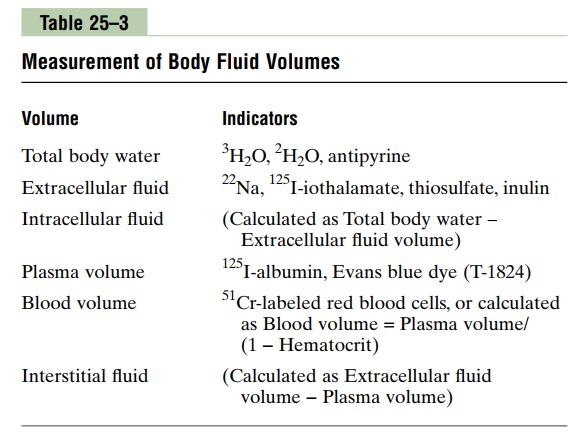Chapter: Medical Physiology: The Body Fluid Compartments: Extracellular and Intracellular Fluids; Interstitial Fluid and Edema
Determination of Volumes of Specific Body Fluid Compartments
Determination of Volumes of Specific Body Fluid Compartments
Measurement of Total Body Water. Radioactive water(tritium, 3H2O) or heavy water (deuterium, 2H2O) can be used to measure total body water. These forms of water mix with the total body water within a few hours after being injected into the blood, and the dilution

principle can be used to calculate total body water (Table 25–3). Another substance that has been used to measure total body water isantipyrine, which is very lipid soluble and can rapidly penetrate cell membranes and distribute itself uniformly throughout the intracel-lular and extracellular compartments.
Measurement of Extracellular Fluid Volume. The volume ofextracellular fluid can be estimated using any of several substances that disperse in the plasma and interstitial fluid but do not readily permeate the cell membrane. They include radioactive sodium, radioactive chloride, radioactive iothalamate, thiosulfate ion, and inulin. When any one of these substances is injected into the blood, it usually disperses almost completely through-out the extracellular fluid within 30 to 60 minutes. Some of these substances, however, such as radioactive sodium, may diffuse into the cells in small amounts. Therefore, one frequently speaks of the sodium space or theinulin space, instead of calling the measurement the true extracellular fluid volume.
Calculation of Intracellular Volume. The intracellularvolume cannot be measured directly. However, it can be calculated as
Intracellular volume = Total body water – Extracellular volume
Measurement of Plasma Volume. To measure plasmavolume, a substance must be used that does not readily penetrate capillary membranes but remains in the vas-cular system after injection. One of the most commonly used substances for measuring plasma volume is serum albumin labeled with radioactive iodine (125I-albumin). Also, dyes that avidly bind to the plasma proteins, such asEvans blue dye (also called T-1824), can be used to measure plasma volume.
Calculation of Interstitial Fluid Volume. Interstitialfluidvolume cannot be measured directly, but it can be cal-culated as
Interstitial fluid volume = Extracellular fluid volume – Plasma volume
Measurement of Blood Volume. If one measures plasmavolume using the methods described earlier, blood volume can also be calculated if one knows the hematocrit (the fraction of the total blood volume com- posed of cells), using the following equation:

For example, if plasma volume is 3 liters and hemat-ocrit is 0.40, total blood volume would be calculated as

Another way to measure blood volume is to inject into the circulation red blood cells that have been labeled with radioactive material. After these mix in the circulation, the radioactivity of a mixed blood sample can be measured, and the total blood volume can be cal-culated using the dilution principle. A substance fre- quently used to label the red blood cells is radioactive chromium (51Cr), which binds tightly with the red blood cells.
Related Topics